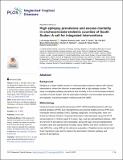High epilepsy prevalence and excess mortality in onchocerciasis-endemic counties of South Sudan: A call for integrated interventions
Publication Date
2025-06-30Type
Article, Journalviews
downloads
Metadata
Show full item recordCitation
TY - JOUR AU - Amaral, Luís-Jorge AU - Jada, Stephen AU - Carter, Jane AU - Bol, Yak AU - Basáñez, María-Gloria AU - Newton, Charles AU - Siewe Fodjo, Joseph Nelson AU - Colebunders, Robert PY - 2025/06/30 SP - e0013244 T1 - High epilepsy prevalence and excess mortality in onchocerciasis-endemic counties of South Sudan: A call for integrated interventions VL - 19 DO - 10.1371/journal.pntd.0013244 JO - PLOS Neglected Tropical Diseases ER -
Abstract/
Background Epilepsy is a major health concern in onchocerciasis-endemic regions with intense transmission, where the infection is associated with a high epilepsy burden. This study investigated epilepsy prevalence and mortality in five onchocerciasis-endemic counties of South Sudan, and the association between onchocerciasis transmission and epilepsy, including probable nodding syndrome (pNS). Methodology House-to-house cross-sectional surveys (2021–2024) identified persons with suspected epilepsy (sPWE) and retrospectively documented deaths among sPWE and individuals without epilepsy (IWE). Epilepsy diagnoses, including pNS, were confirmed by trained clinicians. Ongoing transmission was assessed using anti-Ov16 seroprevalence in children aged 3‒9 years. Age- and sex-standardised epilepsy, pNS and anti-Ov16 prevalence were calculated, along with age- and sex-standardised mortality rates and standardised mortality ratios (SMRs) with 95% confidence intervals (95%CIs), using IWE as the reference population. Weighted arcsin-transformed linear regression was used to explore the association between epilepsy and anti-Ov16 prevalence. Principal findings Among 34,019 individuals screened, 166 deaths occurred in 3,101 person-years for sPWE versus 466 deaths in 63,420 person-years for IWE. Epilepsy prevalence was 4.1% (range: 2.3-7.1%), and pNS prevalence was 1.5% (range: 0.6-2.2%). Anti-Ov16 seroprevalence among children was 23.3% (range: 1.4-44.1%). Each 1.0 percentage point increase in standardised anti-Ov16 seroprevalence was statistically significantly associated with an average rise of 0.10 percentage points in standardised epilepsy prevalence and 0.04 percentage points in standardised pNS prevalence. Median age at death was lower for sPWE (20 years) than IWE (38 years; Mann-Whitney U-test p-value < 0.0001). Standardised mortality rates per 1,000 person-years were statistically significantly higher in sPWE (67.6, 95%CI: 52.6-87.1) than in IWE (9.0, 95%CI: 7.8-10.3). The overall SMR was 6.9 (95%CI: 5.9-8.0), indicating sPWE were seven times more likely to die than IWE. Significance The high epilepsy burden in onchocerciasis-endemic areas is driven by elevated epilepsy prevalence and mortality. Integrated onchocerciasis and epilepsy programmes must be strengthened to decrease epilepsy incidence and ensure uninterrupted access to antiseizure medication.

